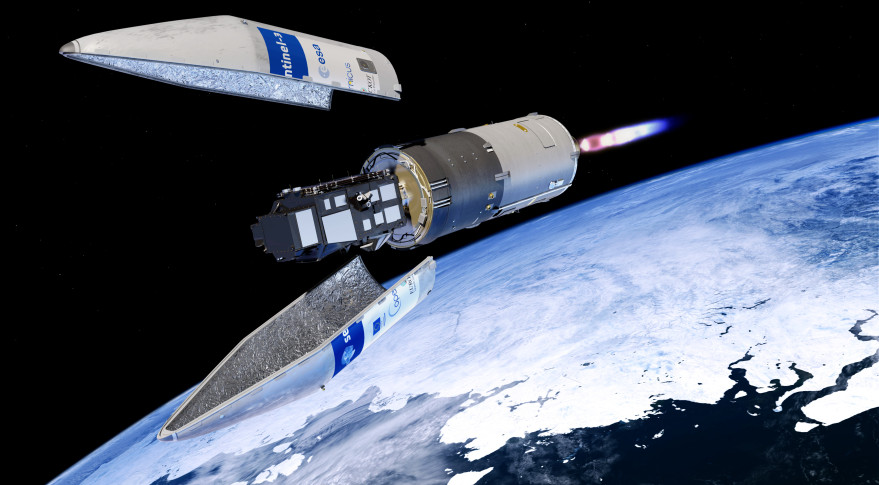Europe's Sentinel-3A Earth Observation Satellite Successfully Launched

DARMSTADT, Germany — Europe's Sentinel-3A Earth observation satellite on Feb. 16 was successfully placed into low Earth orbit aboard a German-Russian Rockot launch vehicle operating from the Plesetsk Cosmodrome in northern Russia.
Officials at the European Space Agency's space operations center, ESOC, here confirmed that the satellite was in the correct location and sending signals via a ground station in Kiruna, Sweden and that its solar panels had correctly deployed.
The launch is the latest milestone in Europe's multibillion-euro Copernicus environment-monitoring network, which features a half-dozen satellite families, several of which have been ordered in batches to assure an uninterrupted data flow for a decade or more.
That is the case with Sentinel-3A, whose multi-instrument payload will monitor ocean wave height, sea and land temperature, sea-ice area and thickness and contribute to weather forecasting.
Europe's 30-nation Eumetsat organization, based here, will operate Sentinel-3A after a five-month commissioning phase managed by the 22-nation European Space Agency (ESA).
The European Commission — the executive arm of the 28-nation European Union — owns the Copernicus network and has set aside 4.3 billion euros for it in its current seven-year budget running to 2020.
With a recent prime contract award to Thales Alenia Space of France and Italy for the third and fourth copies of Sentinel-3A satellites, this piece of the Copernicus puzzle is now assured of data continuity for at least 14 years – each satellite has a minimum expected life of seven years – and more like 24 years given the amount of on-board fuel each spacecraft carries.
Get the Space.com Newsletter
Breaking space news, the latest updates on rocket launches, skywatching events and more!
Sentinel-3A was contracted in April 2008, with the identical 3B contracted in early 2010 for a total of 530 million euros, or $576 million at today’s exchange rates, for the two satellites. The 3C and 3D models were contracted earlier this year in a single contract that valued each satellite at 225 million euros.
Volker Liebig, director of Earth observation at ESA, said the 3C and 3D units cost about the same as the 3B ordered six years earlier. Liebig said the entire Sentinel satellite program is now less than 5 percent over its initial cost estimate, made in 2005, despite the fact that, in part owning to European Commission rules, ESA was unable to make bulk purchases of the Sentinel 1, 2 and 3 series – a total of 12 satellites.
Given the recent costs of the C and D units for Sentinels 1, 2 and 3, it is all but certain that by 2020 the program will have come in under its initial budget. "I don't know many public infrastructure programs that can say that," Liebig said. "It was only possible by working very closely with European industry, so Sentinel is an industrial success as well."
Sentinel-3B is scheduled for launch, aboard a European Vega rocket, in mid-2017, with the 3C and 3D units set to be ready as soon as 2019 or 2020, depending on when they are needed.
The Sentinels 1, 2 and 3 series are all designed to operate as two-satellite missions, with the spacecraft spaced 180 degrees from each other. The Sentinel-3 satellites operate from 815 kilometers in a polar, sun-synchronous orbit.
The European Commission estimates that, with six Sentinel satellites in orbit, the program will be beaming down 8 terabytes per day of data, making Copernicus a Big Data challenge.
This story was provided by SpaceNews, dedicated to covering all aspects of the space industry.
Join our Space Forums to keep talking space on the latest missions, night sky and more! And if you have a news tip, correction or comment, let us know at: community@space.com.
Peter B. de Selding is the co-founder and chief editor of SpaceIntelReport.com, a website dedicated to the latest space industry news and developments that launched in 2017. Prior to founding SpaceIntelReport, Peter spent 26 years as the Paris bureau chief for SpaceNews, an industry publication. At SpaceNews, Peter covered the commercial satellite, launch and international space market. He continues that work at SpaceIntelReport. You can follow Peter's latest project on Twitter at @pbdes.












